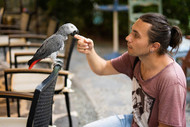Are You Teaching Your Parrot To Bite? Why Parrots Bite
Posted by Parrot Biting, Stop Parrots Biting, Why Parrots Bite, Parrot Behaviour, Parrot Training on 9/1/2024
Steve Hartman of The Parrot University tells us what to do if you?re teaching your Parrot to bite.
A significant but seldom noticed issue many pet birds deal with is being forced to interact with strangers they do not trust. In almost all cases a well-adjusted flighted pet bird will hesitate, possibly fly a few feet back, while they take time to decide if they want to interact with a new person.
This is normal survival instinct for a Parrot. Unfortunately many young Parrots are promoted by their owners to do something they would not normally do as an adult.
Humans
Overall the structure of Parrots? social behaviour is very similar to humans. However, there is a significant underlying difference, humans are predators and Parrots are prey.

Have all new people sit on the couch before you approach with your bird. The first time you may need a little encouragement. Soon he will learn the process.
As a predator humans are less concerned about new situations because we have few threats in life. Parrots differ because in the back of their minds they are always cautious of the knowledge they are on multiple lunch menus. For this reason we must be particular aware of the different way a young Parrot?s brain is learning about the world.
When a nurturing human provides a protected environment a baby Parrot will develop the confidence to be outgoing and learn about the world.
Development
This is the same development stage in humans we call ?freely exploring the environment?. As long as the nurturing parent is in the picture the young bird can feel confident to step onto and explore a stranger?s hand.
This may seem like a good way to teach a cooperative baby to like strangers but the babies? brain may actually be learning just the opposite.

The guy feels comfortable and is already focused on the treat.
Because they are a prey species and need to fend for themselves sooner in the wild, Parrots progress through this initial compliant development phase at a much more rapid pace than humans.
Before 6 months old Parrots have reached a stage that occurs in humans at about 3 years when we begin to ?reason? why we doing something. No longer do we blindly follow the parent, we want to start participating in making decisions on a conscience level.
Strangers
For a few months the compliant baby is passed around to strangers without much objection. We assume this is OK and the baby likes the attention.
However, during this stage the baby is complying because nature has programmed him to blindly follow the parents lead.
As the baby starts to ?reason? he will likely be second guessing mom and dad and begin hesitating before he goes to strangers. Without understanding this transition the baby is going through the parent usually gently insist.
It only takes a few occurrences for the rapidly maturing baby to decide this is a problem and develop an aversion to new people.
Adults
For all young Parrots and any adult Parrots that cannot fly; do not allow any new person to approach your bird, allow the bird to make the decision to approach on its own, in its own good time.
There may be people your bird will never trust. Leave the decision to approach up to him.

From a bird?s perspective as a prey species much of human body language can be intuitively threatening because we are basically predators. Compound this with the specific threatening body language we display when we think we may get bit, and hesitate reaching our hand all the way, or lean back just a little bit as we do reach out our hand.
Even I with 30+ years? experience distrust Parrots I do not know, and they can tell.
Solution to teaching your bird to like strangers
When humans are sitting it is much more difficult to look and act like we are afraid or a threat.
Develop a routine where all new persons sit down on the couch when they first meet your bird. Provide the new human with a favourite treat and put your bird on the other end of the couch or on your lap on the other end of the couch. Then allow your bird to discover that new persons can be friendly and they come with gifts.
Encouragement is not necessary, just be there and allow him to progress totally on his own. He will learn to like this experience at his own pace. If the bird only goes just far enough to get the treat have your friend progressively hold the treat further over their legs so the bird needs to step onto the leg for the reward.
Stepping
Stepping onto a stranger?s hand should only be encouraged once your bird has decided this really is a friend.
Use this technique for all young and flightless adult birds for the first few years and as an adult they will be more comfortable and likely choose to seek out new friends.

Successful low stress encounters with new people will encourage him to trust more people as an adult.
Remember: A small amount of time spent at the beginning of his life will pay off for the rest of his lifetime.
Learn more about the causes of biting and how to prevent it here.
This article was originally published on The Parrot University?s blog in March 2016.

